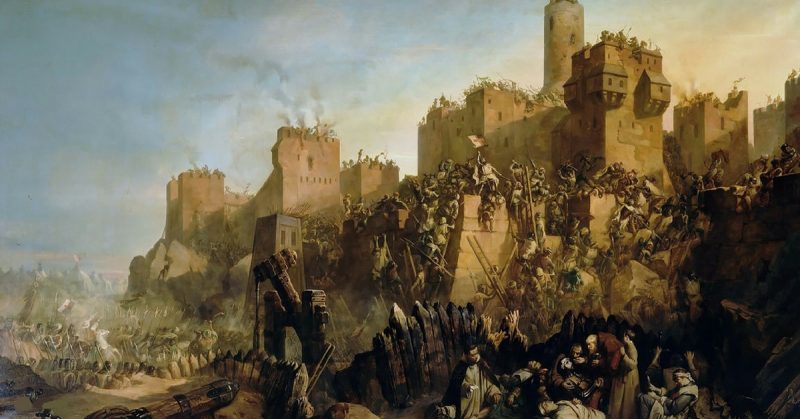Combining knightly warfare and a monastic lifestyle, the knightly crusading orders were one of the strongest institutions of medieval Europe.
Through them, men sought a blood-stained salvation by fighting for God.
The Knights Templar
The first order founded in the Holy Land, the Knights of the Temple were created in 1115 by Hugue de Payens and Godfrey de Saint Adhemar, who recruited seven other French knights to help them escort pilgrims safely between Jerusalem, Jericho and the traditional site of Jesus’s baptism in the Jordan.
Growing in size and prominence, the group took up quarters at the Temple of Solomon – hence their name – and set the precedent for such groups as warrior monks.
The Hospitallers of St John
The Hospital of St John was founded in Jerusalem around 1070 as a place of rest for pilgrims. Following the First Crusade and the example of the Templars, the Hospitallers took up arms in the 1120s, becoming another order of warrior monks.
Their order was divided between those who fought and those who retained a more traditional, non-violent religious role.
The Knights of St Lazarus
Founded shortly after the Hospitallers, the Knights of St Lazarus were also based in Jerusalem, possibly arising around a pre-crusade leper hospital. Most of the knights of this order were lepers, and Hospitallers who caught the disease had to transfer to the Knights of Lazarus.
Even their lay sergeants were lepers, commoners recruited to fight alongside knights who suffered the same disease.
The Hospitallers of St Thomas of Canterbury
Founded during the 1189-90 siege of Acre, the Hospitallers of St Thomas were an English order named after Thomas Becket, the recently martyred Archbishop of Canterbury.
It was never a large order, as it was limited to English knights, and many of its potential members preferred to join larger orders, especially the Hospitallers of St John.
The Teutonic Knights
Also founded during the Siege of Acre, the Teutonic Knights were another order with a distinct regional identity, made up mostly of Germans. Formally acknowledged by the Pope in 1199, they became a common home for crusaders from central Europe in the Holy Land. Despite the order’s popularity, the power of the Hospitallers and the Templars limited the ability of the Teutonic Knights to gain castles and positions of influence in the Holy Land.
Shifting their focus to Eastern Europe, the Teutonic Knights crusaded against pagans in the region, becoming the leading crusading order on that front. Their wars in Prussia, Poland, and Lithuania contributed to the eastern expansion of European society and of Christendom, and they became a powerful political force and major landowners in the process.
The Sword Brethren
Founded in Livonia in 1201, the city of Riga was a colony intended to support the eastward expansion of Christian Europe. Around 1202, the Fratres Militiae Christi, generally known as the Brethren of the Sword, were established there for the defence of the colony. A Cistercian order of monastic warriors, they were the second most significant knightly order in Eastern Europe.
Initially successful in conquering Livonian lands, the Sword Brethren suffered a huge defeat at Siauliai in 1236, losing half their members. Never having gained the power and influence of the Teutonic Knights, they were largely absorbed into that order following the disaster.
The Knights of Calatrava
The Iberian Peninsula was a battleground between Christendom and Islam before the crusades to the Holy Land began. The Reconquista, the series of wars that re-Christianised the region, lasted from the early 11th to the late 15th centuries. Yet while the Templars and Hospitallers took part in fighting there, there were no Spanish orders on the same scale.
One of those that did emerge was the Knights of Calatrava.
When the Templars abandoned the royal castle of Calatrava in 1157, a group of Cistercian monks and Navarrese soldiers took over its defence, forming a new military-religious brotherhood. Within a year, they cleared the surrounding region of bandits. From there, they expanded to fight elsewhere in Spain, temporarily changing their base and name while Calatrava was briefly occupied by Moors.
The Knights of Santiago
In the late 1150s, a band of 13 Castillian knights offered their services to protect pilgrims travelling to the famous Spanish shrine of St James at Compostella. Expanding to become a significant force in the Reconquista, the Knights of Santiago gained fame and lands across Europe but did not have the numbers to play a significant part in all the campaigns they were invited on.
The Knights of Santiago were distinct from other orders in not being monastic. Though their rules were based on those of the Augustinian monks and the Templars, they were significantly different in being allowed to marry and own personal possessions.
The Order of St James of Altopascio
Also known as the Order of the Tau because of their symbol, the Order of St James of Altopascio was an Italian warrior brotherhood, and arguably the first knightly order.
A hospital was founded by Augustinian monks at Altopascio sometime before 952, and by 1056 they had become militarized, protecting pilgrims along the dangerous roads between Lucca and Genoa. An institution ahead of their time, the Order of the Tau did not gain papal recognition as a military order until 1239, and though the order built hospitals elsewhere its numbers were never large.
The Knights of San Stefano of Tuscany
While most knightly orders were founded at the height of the Middle Ages, the Knights of San Stefano were not founded until 1561. Created by Grand Duke Cosimo de Medici, their Masters were drawn from the Grand Dukes and they followed the Benedictine rule. Their role was to fight corsairs in the Mediterranean, and they took part in the Battle of Lepanto in 1571, the action that ended Turkish strength at sea.
Sources:
- Jonathan Riley-Smith, ed. (1994), The Oxford Illustrated History of the Crusades.
- Terence Wise and Richard Scollins (1984), The Knights of Christ.
